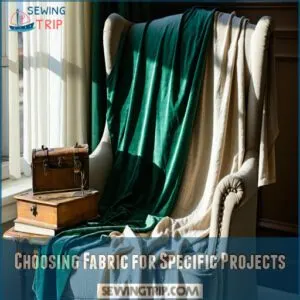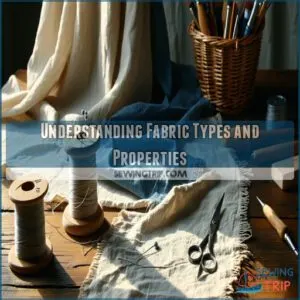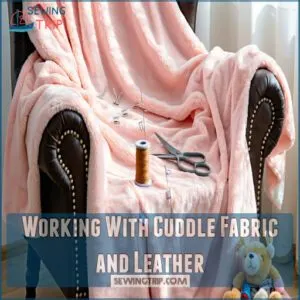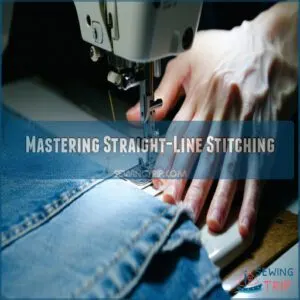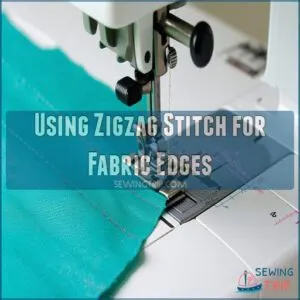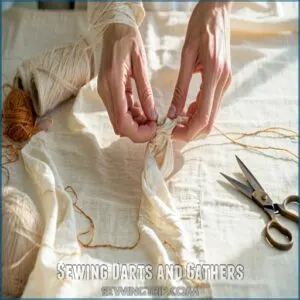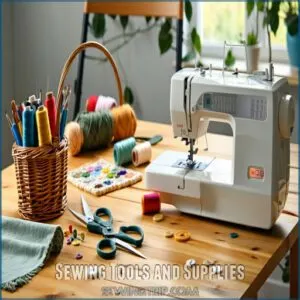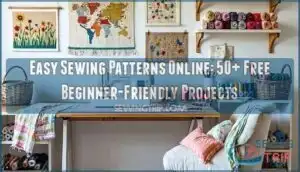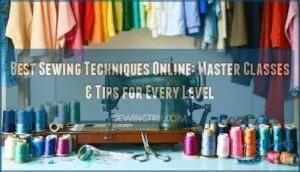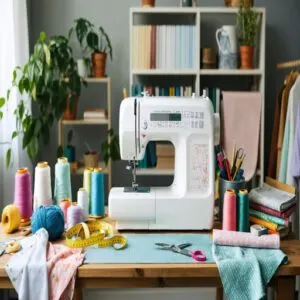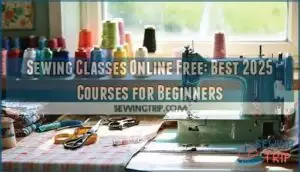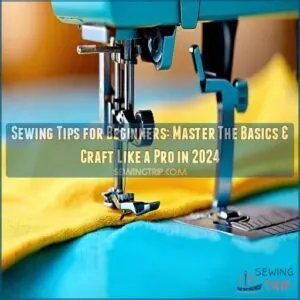This site is supported by our readers. We may earn a commission, at no cost to you, if you purchase through links.
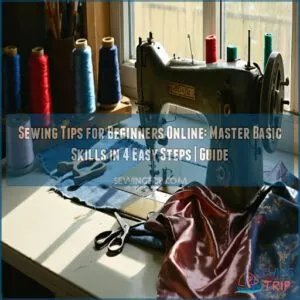 You’ll find essential sewing tips for beginners online that’ll transform you from novice to confident crafter. Start by mastering your machine’s threading guide and testing tension on scrap fabric.
You’ll find essential sewing tips for beginners online that’ll transform you from novice to confident crafter. Start by mastering your machine’s threading guide and testing tension on scrap fabric.
Choose the right needle – universal for woven fabrics, ballpoint for knits – and match thread weight to your fabric. Practice straight stitching at slow speeds, using drawn lines as guides.
Don’t skip pre-washing fabric to prevent unwanted shrinkage later. Keep your needle down when pivoting, and you’ll be turning corners like a pro.
There’s a whole world of advanced techniques waiting once you’ve nailed these fundamentals.
Table Of Contents
Key Takeaways
- You’ll want to start with proper machine setup – follow the threading guide carefully, test tension on scrap fabric, and choose the right needle for your material (universal for woven, ballpoint for knits).
- You need to pre-wash your fabric before starting any project to prevent unwanted shrinkage and maintain the perfect fit of your finished garment.
- You’ll master straight stitching faster by practicing at slow speeds, using drawn lines as guides, and keeping your needle down when pivoting corners.
- You should invest in quality tools – dedicated fabric scissors, proper thread weight matched to your fabric, and organizing your workspace with essential supplies within arm’s reach.
Sewing Machine Basics
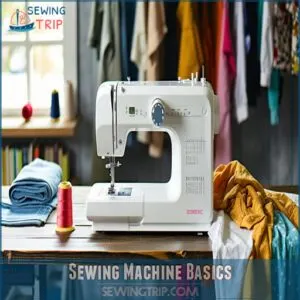
You’ll quickly master your sewing machine by learning basic skills like threading, tension control, and needle handling.
Understanding these fundamentals will help you create beautiful projects while preventing common mistakes that can damage your machine or fabric.
Threading and Tension Adjustment
Through proper threading and tension adjustment, you’ll master your sewing machine’s basic operations. Your thread tension affects stitch quality and overall results. Proper sewing machine thread tension is essential for successful sewing.
- Start by following your machine’s numbered threading guide from top to bottom
- Wind bobbin evenly and place it correctly in the case
- Test tension on scrap fabric before starting projects
- Adjust top tension dial in small increments
- Check both sides of stitching for balanced tension
These threading tips assure precise, professional-looking stitches every time, and by following them, you will achieve successful sewing with proper techniques.
Inserting and Removing Needles
Now that you’ve got your machine threaded, let’s get that needle in safely.
Always turn off your machine first – trust me, it’s a habit worth building!
Position the needle with its flat side facing back, then slide it up as far as it’ll go.
Tighten the screw firmly but don’t overdo it. When removing, loosen the screw and pull straight down, it’s as simple as that!
Choosing Right Needle and Thread
Selecting the right needle and thread combination acts like your sewing project’s foundation. You’ll need to match your thread types to both your fabric and needle sizes.
Universal needles work for most woven fabrics, while ballpoint needles suit knits. Understanding different sewing needle types is essential for successful projects.
Choose thread that matches your fabric weight – lighter fabrics need finer thread, while denim requires heavy-duty options. This pairing guarantees best stitch quality and tension control.
Practicing Straight Stitches and Pivoting
While mastering straight stitches might seem intimidating, you’ll develop pivot control through practice.
Start with slow sewing speed on scrap fabric, focusing on maintaining even stitch length. Draw practice lines on fabric for guidance, and try basic shapes like squares.
When pivoting, keep the needle down, lift the presser foot, and rotate your fabric smoothly. You’ll build accuracy with each practice session, and over time, develop smooth techniques.
Fabric Selection Tips
You’ll need the right fabric for your sewing project just like you need the right ingredients for a recipe.
Whether you’re making a cozy blanket or a summer dress, knowing how to pick your fabric will save you time and help you create something you’ll love to use.
Pre-Washing Fabric to Prevent Shrinkage
Before diving into your sewing project, pre-washing fabric is your first line of defense against unwanted shrinkage.
You’ll thank yourself later when your finished garment maintains its perfect fit after washing.
Here are three essential fabric care steps:
- Wash fabric using the same temperature settings you’ll use for the final garment
- Dry according to fabric care instructions
- Iron while slightly damp to remove wrinkles, ensuring a perfect fit.
Choosing Fabric for Specific Projects
Now that your fabric is pre-washed, let’s match it to your project.
Think about how your finished piece will be used – is it for cozy pajamas or a structured blazer? Your fabric’s purpose shapes every choice.
Consider movement needs, weather conditions, and care routines. Read online descriptions carefully and start a fabric swatch journal to test different textiles.
You’ll develop a feel for what works best. Understanding fabric properties is essential for a successful sewing project.
Understanding Fabric Types and Properties
Now that you’ve picked your project fabric, let’s understand what makes it tick.
Think of fabric like a personality – each type has its quirks and charms.
Here’s what affects how your fabric behaves:
- Fabric density determines how heavy or light it feels
- Weave types impact durability and drape
- Fiber content influences care requirements
- Thread count affects softness and breathability
You’ll find natural fibers like cotton breathe better, while synthetics often stretch more.
Understanding cotton fabric properties is paramount for selecting the right material for your sewing project, considering the fiber content and its impact on the overall fabric density.
Working With Cuddle Fabric and Leather
Ready to tackle special fabrics? Let’s explore working with cuddle fabric and leather. You’ll need different tools and techniques for each material.
For Cuddle fabrics, proper sewing preparation is essential, as outlined in the tips for sewing preparation is essential.
The following table summarizes the key information for working with various fabrics:
| Material | Tools Needed | Special Tips | Care Instructions | Best Projects |
|---|---|---|---|---|
| Cuddle | Walking foot, #90/14 needle | Use clips 1" apart | Lint roll frequently | Blankets, toys |
| Leather | Leather needle, heavy thread | No pins, use clips | Clean with leather soap | Bags, wallets |
| Faux Leather | Universal needle, clips | Low heat iron | Wipe with damp cloth | Accessories |
| Minky | Walking foot, sharp needle | Reduce pressure | Gentle wash cycle | Baby items |
| Velvet | Walking foot, fine needle | One-way nap | Dry clean only | Home decor |
When working with these fabrics, it’s crucial to follow the special tips and care instructions to achieve the best results and ensure the longevity of your projects, whether you’re making blankets, toys, or other items like bags and wallets.
Essential Sewing Techniques
You’ll learn three essential sewing techniques that form the building blocks of any successful project: straight-line stitching, zigzag edges, and creating darts and gathers.
With these core skills under your belt, you’ll be ready to tackle more advanced projects with confidence.
Mastering Straight-Line Stitching
Now that you’ve selected your fabric, let’s master the bedrock of all sewing skills – straight-line stitching.
You’ll want to start with basic stitch control by marking guide lines on scrap fabric. Keep your hands steady and guide the fabric gently – don’t push or pull.
Watch your seam accuracy by aligning the fabric edge with your machine’s guide marks. Remember, slow and steady wins this race!
Using Zigzag Stitch for Fabric Edges
When you’re ready to tackle fabric edges, the zigzag stitch is your best friend.
Additionally, it prevents fraying while adding a professional finish to your projects.
Set your machine’s stitch width between 2.0-2.5mm and length at 1.5-2.0mm for best results.
Keep the needle landing just off the fabric’s edge while stitching, and you’ll have neat, durable seams every time.
Mastering edge finishing techniques is essential for achieving professional-looking results in your sewing projects.
Sewing Darts and Gathers
Now that you’ve mastered zigzag edges, let’s shape your fabric with darts and gathers.
These techniques add structure to your garments. Start by marking dart points with pins, then fold and stitch to create shape.
For gathers, sew two parallel lines and gently pull the threads to create soft folds.
Practice these fabric manipulation methods on scrap material first to perfect your stitch control.
Sewing Tools and Supplies
You’ll need the right tools to make your sewing projects smooth and enjoyable, from sharp fabric scissors to essential sewing notions like pins and thread.
With a well-organized sewing space and quality supplies at your fingertips, you’ll be ready to tackle any project that catches your eye.
Investing in Quality Fabric Scissors
Now that you’ve mastered basic stitches, let’s talk about your most important tool – fabric scissors. You’ll want a pair dedicated just for fabric, since using them on paper dulls the blades quickly.
A wide selection of fabric scissors is available online. Test sharpness by cutting silk chiffon – clean cuts mean they’re sharp.
- Look for ergonomic handles that fit your grip comfortably
- Store them in a protective case between uses
- Consider getting both 8-inch and 5-inch pairs for different cutting tasks
Your scissors are like a chef’s knife – treat them well and they’ll make every project easier.
Understanding Sewing Notions and Threads
Sewing notions and thread choices can make or break your project.
You’ll need basic notions like pins, seam rippers, and measuring tape for successful sewing.
When selecting thread types, match the weight to your fabric – lighter threads for delicate materials, heavier ones for durable fabrics.
Keep a variety of colors handy, and don’t forget to check thread tension before starting.
Quality threads prevent frustrating breaks and guarantee clean stitches.
Using Sewing Machine Feet for Specific Tasks
While your sewing journey unfolds, you’ll discover how different machine feet transform your projects.
The Edge Stitch Foot creates perfect topstitching, while the Buttonhole Foot guarantees identical buttonholes every time.
For thick fabrics, reach for the Walking Foot to prevent layers from shifting.
When working with stretch materials, the Knit Foot becomes your best friend, gripping and releasing fabric smoothly with each stitch.
Understanding various sewing machine feet is essential for mastering specific sewing techniques.
Organizing Sewing Space for Efficiency
Now that you’ve got your specialty feet sorted, let’s make your workspace work smarter.
A well-organized sewing station boosts your efficiency and creativity.
Here are 3 game-changing storage solutions:
- Keep thread, scissors, and pins within arm’s reach on a magnetic board
- Use clear containers to sort fabric by color or project
- Install good lighting above your machine and cutting area
Frequently Asked Questions (FAQs)
How do I learn sewing basics?
Start with online tutorials and practice basic stitches. You’ll need a machine, thread, and fabric. Try simple projects like pillowcases first. Join online communities for support and resources you’ll need.
What are the best sewing tips for beginners?
Choose quality tools, learn machine basics, and practice on scrap fabric. You’ll need sharp scissors, proper needles, and good thread. Watch tutorials, join online communities, and don’t rush your projects.
Is it time to practice sewing for beginners?
Like a seed sprouting into a flower, your sewing journey starts now.
You’ll learn best by diving in, practicing daily, and building confidence.
Don’t wait – grab your machine and let’s begin.
Should you learn to sew online?
You’ll find excellent online sewing tutorials on platforms like YouTube and Skillshare.
They’re convenient, cost-effective, and let you learn at your own pace.
Plus, you can replay tricky techniques until you master them.
What do you need to start sewing?
You’ll need a humble needle and thread, your trusty sewing machine, quality fabric scissors, straight pins, a measuring tape, and various fabrics to begin your creative journey into the craft of sewing.
This list of tools is essential for starting your sewing project, and having them will allow you to begin your creative journey into the craft of sewing.
Where can I find the best sewing techniques online?
YouTube tutorials, Skillshare classes, and Instagram sewing accounts offer excellent techniques.
You’ll discover step-by-step guides on platforms like Udemy and Pinterest that’ll help you master everything from basic stitches to advanced patterns.
What is the first thing a beginner should sew?
Start with a simple square cushion cover or pillowcase – you’ll practice straight lines and basic seams.
It’s satisfying, practical, and you won’t feel overwhelmed.
Plus, you’ll have something useful when you’re done!
Is it possible to learn sewing online?
You’ll discover excellent online sewing tutorials through platforms like Skillshare and Udemy.
They’re packed with step-by-step guides, from basic stitches to complex patterns, making it convenient to learn at your own pace.
What is the most important rule of sewing?
You’ll want to maintain consistent tension in your thread and fabric while sewing. If you’re not managing tension properly, your stitches won’t hold and your project could unravel.
What is the hardest thing about sewing?
You’ll find maintaining consistent tension and straight stitches challenging at first.
Getting fabric to feed evenly through your machine takes practice, but don’t worry – everyone struggles with these basics initially.
Conclusion
Like a garden that grows from tiny seeds, your sewing journey starts with these fundamental steps.
By following these sewing tips for beginners online, you’ll build confidence with each stitch.
Remember, every expert seamstress started exactly where you’re today, keep practicing, stay patient with yourself, and don’t be afraid to try new techniques.
Soon you’ll transform simple fabric into beautiful creations, mastering your machine like a skilled artisan, your creative adventure is just beginning.
- https://crazylittleprojects.com/sewing-for-beginners-learn-to-sew/
- https://sewing.com/basic-sewing-skills/
- https://madamsew.com/blogs/sewing-blog/sewing-techniques-you-should-learn-first
- https://www.seasonedhomemaker.com/sewing-tips-for-beginners/
- https://beginnersewingprojects.com/how-to-sew-for-beginners/


